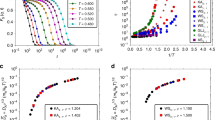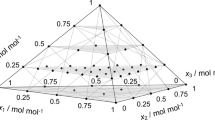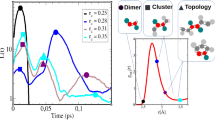Abstract
RECENT statistical theories of liquid mixtures have made it possible to calculate the excess thermodynamic functions of binary mixtures from the parameters characterizing the intermolecular potential-energy curves for the two pairs of like molecules. For small molecules, between which only dispersion forces are supposed to operate, these parameters may conveniently be taken to be ε11, the minimum value of the potential energy, and r11 the molecular separation corresponding to this minimum (for a pair of like molecules of species 1). The theories are of two types. Those of the first type use a definite model for the liquid, and enable the excess functions to be calculated from the appropriate ε and r values alone. This applies to the treatment of Prigogine and Mathot1 (and its extension by Prigogine and Bellemans2) and to that of Salsburg and Kirkwood3. In treatments of the second type4,5, based on the theory of corresponding states, the excess functions are expressed in terms of (a) the ratios ε11/ε22 and r11/r22 and (b) the macroscopic properties of one of the two pure components, chosen as reference substance. Thus, the excess volume, VE, depends on the molar volume of the reference liquid and the temperature variation of this volume.
This is a preview of subscription content, access via your institution
Access options
Subscribe to this journal
Receive 51 print issues and online access
$199.00 per year
only $3.90 per issue
Buy this article
- Purchase on Springer Link
- Instant access to full article PDF
Prices may be subject to local taxes which are calculated during checkout
Similar content being viewed by others
References
Prigogine and Mathot, J. Chem. Phys., 20, 249 (1952).
Prigogine and Bellemans, Disc. Farad. Soc., No. 15, 80 (1953).
Salsburg and Kirkwood, J. Chem. Phys., 21, 2169 (1953).
Prigogine, Bellemans and Englert-Chwoles, J. Chem. Phys., 24, 518 (1956).
Scott, J. Chem. Phys., 25, 193 (1956).
Mathot, Staveley, Young and Parsonage, Trans. Farad. Soc., 52, 1488 (1956).
Hirschfelder, Curtiss and Bird, “Molecular Theory of Gases and Liquids” (Wiley and Sons, New York, 1954).
Mathias, Crommelin and Onnes, Comm. Leiden, 117, 131a, 145b (1912).
Author information
Authors and Affiliations
Rights and permissions
About this article
Cite this article
POOL, R., STAVELEY, L. Excess Volumes in Binary Liquid Mixtures of Simple Molecules. Nature 180, 1118–1120 (1957). https://doi.org/10.1038/1801118a0
Issue Date:
DOI: https://doi.org/10.1038/1801118a0
Comments
By submitting a comment you agree to abide by our Terms and Community Guidelines. If you find something abusive or that does not comply with our terms or guidelines please flag it as inappropriate.



